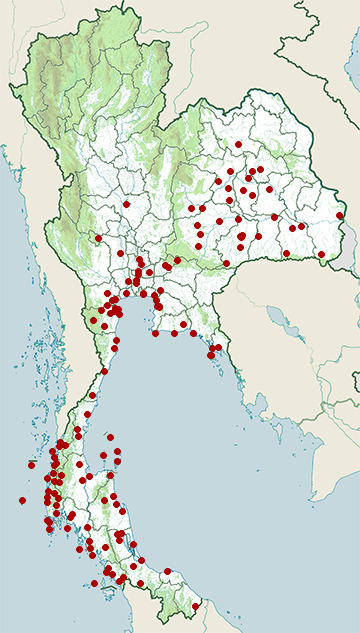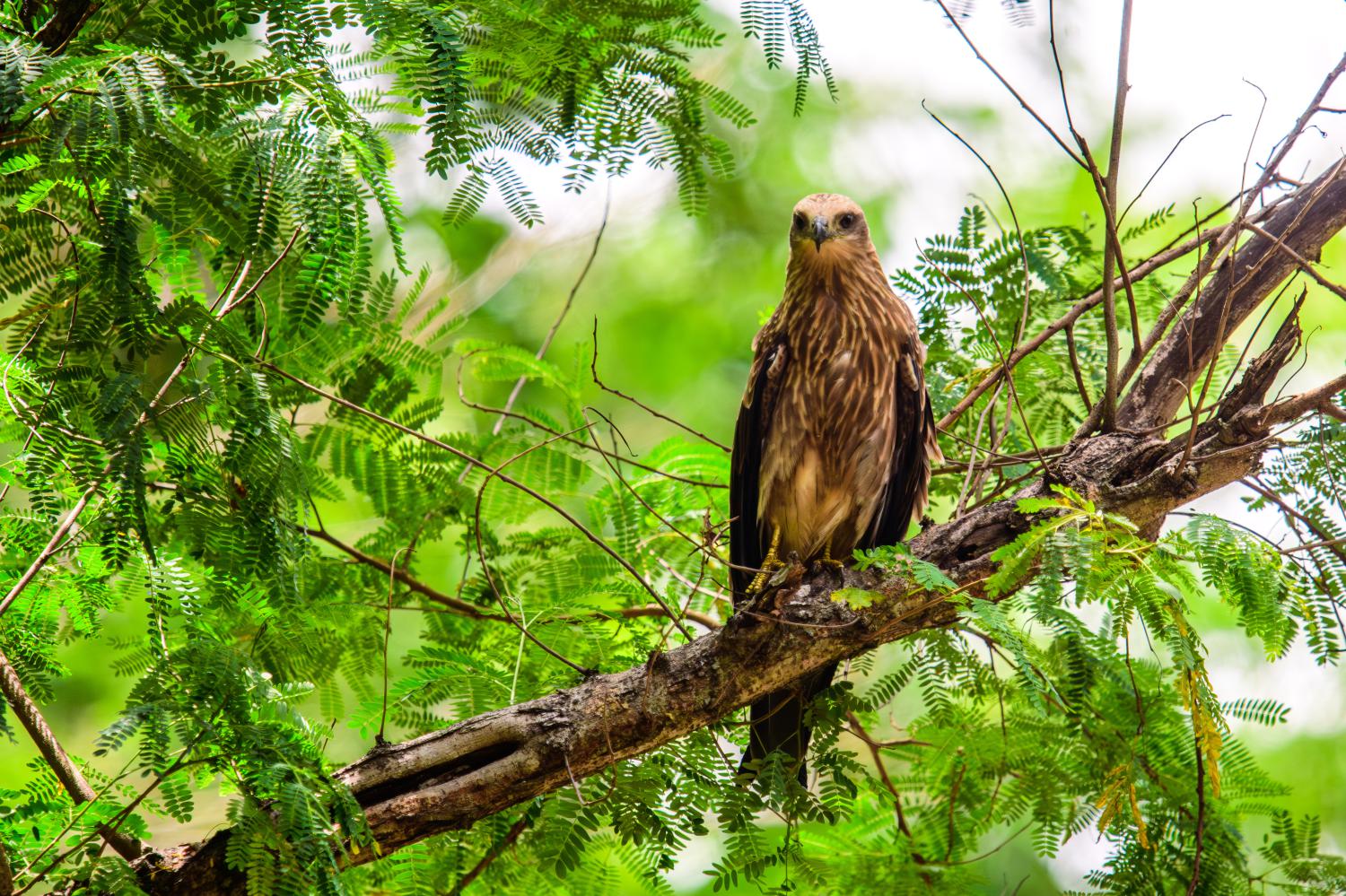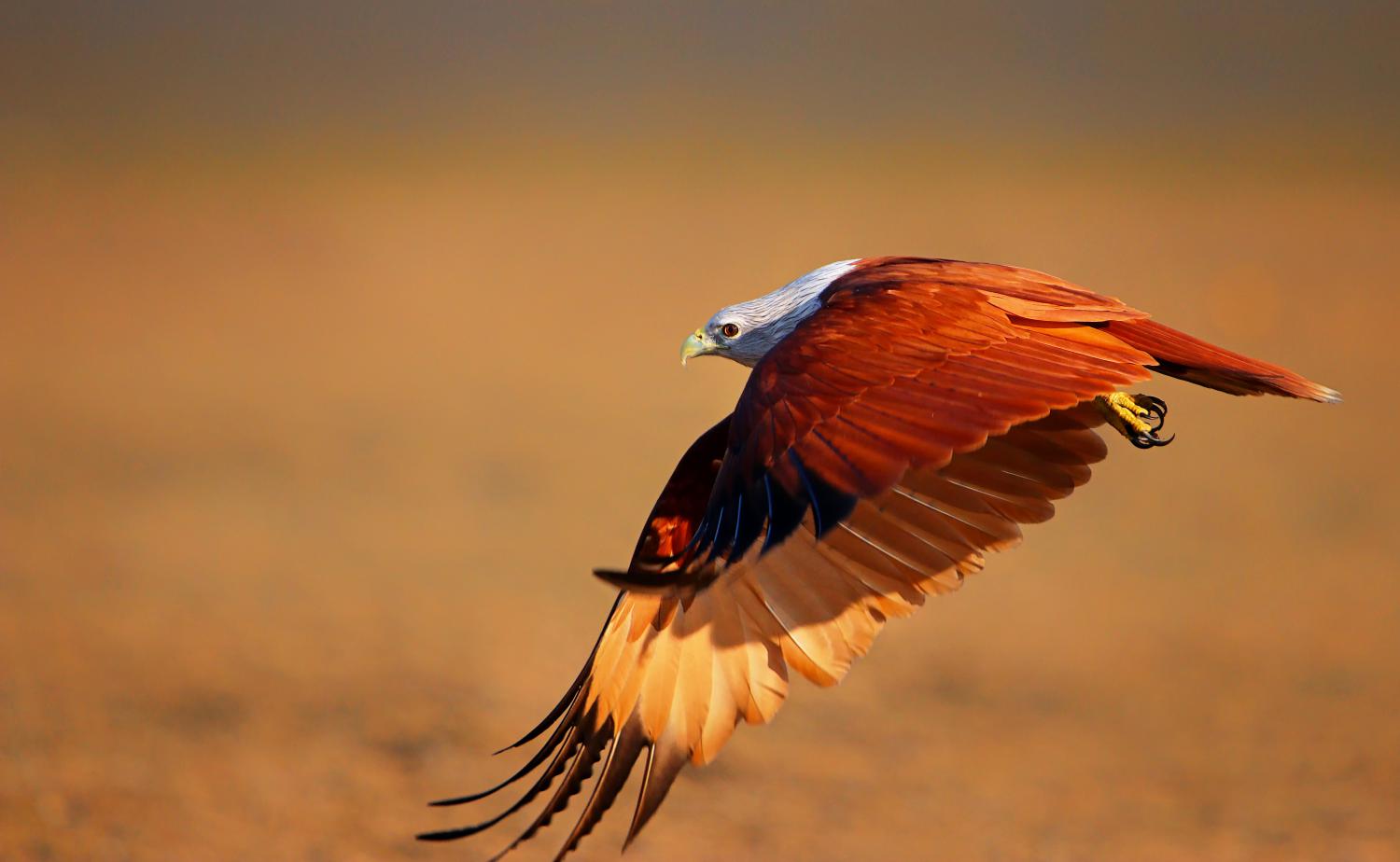Species of Thailand
Brahminy kite
Haliastur indus
Pieter Boddaert, 1783
In Thai: เหยี่ยวแดง
The brahminy kite (Haliastur indus), formerly known as the red-backed sea-eagle in Australia, is a medium-sized bird of prey in the family Accipitridae, which also includes many other diurnal raptors, such as eagles, buzzards, and harriers. They are found in the Indian subcontinent, Southeast Asia, and Australia. They are found mainly on the coast and in inland wetlands, where they feed on dead fish and other prey. Adults have a reddish-brown body plumage contrasting with their white head and breast which make them easy to distinguish from other birds of prey.
Taxonomy
In 1760, French zoologist Mathurin Jacques Brisson described and illustrated the Brahminy kite in the first volume of his Oiseaux based on a specimen collected in Pondicherry, India. He used the French name L'aigle de Pondichery. The brahminy kite was included by the French polymath Georges-Louis Leclerc, Comte de Buffon in his Histoire Naturelle des Oiseaux. It was also illustrated in a hand-coloured plate engraved by François-Nicolas Martinet in the Planches Enluminées D'Histoire Naturelle which was produced under the supervision of Edme-Louis Daubenton to accompany Buffon's text. Neither Brisson nor Buffon included a scientific name but in 1783 the Dutch naturalist Pieter Boddaert coined the binomial name Falco indus in his catalogue of the Planches Enluminées. The brahminy kite is now placed with the whistling kite in the genus Haliastur that was erected by the English naturalist Prideaux John Selby in 1840.
Four subspecies are recognized:
- H. i. indus (Boddaert, 1783) – South Asia
- H. i. intermedius Blyth, 1865 – Malay Peninsula , Greater and Lesser Sunda Islands, Sulawesi and the Philippines
- H. i. girrenera (Vieillot, 1822) – New Guinea, Bismarck Archipelago and north Australia
- H. i. flavirostris Condon & Amadon, 1954 – Solomon Islands
Description
The brahminy kite is distinctive and contrastingly coloured, with chestnut plumage except for the white head and breast and black wing tips. The juveniles are browner, but can be distinguished from both the resident and migratory races of black kites in Asia by the paler appearance, shorter wings, and rounded tail. The pale patch on the underwing carpal region is of a squarish shape and separated from Buteo buzzards.
The brahminy kite is about the same size as the black kite (Milvus migrans) and has a typical kite flight, with wings angled, but its tail is rounded unlike the Milvus species, red kite, and black kite, which have forked tails. The two genera are, however, very close.
The call is a mewing keeyew.
Distribution and status
This kite is a familiar sight in the skies of Sri Lanka, Nepal, India, Pakistan, Bangladesh, and southeast Asia and as far south as New South Wales, Australia, through which region it is widespread and resident. They perform seasonal movements associated with rainfall in some parts of their range.
They are mainly seen in the plains, but can sometimes occur above 5000 feet in the Himalayas.
It is evaluated as being of least concern on the IUCN Red List of Threatened Species. However, the species is on the decline in some parts such as Java.
Behaviour
The breeding season in South Asia is from December to April. In southern and eastern Australia, it is August to October, and April to June in the north and west. The nests are constructed of small branches and sticks with a bowl inside and lined with leaves, and are located in various trees, often mangroves. They show considerable site fidelity nesting in the same area year after year. In some rare instances, they have been seen to nest on the ground under trees. A clutch of two dull-white or bluish-white oval eggs measuring 52 x 41 mm is laid. Both parents take part in nest building and feeding, but likely only the female incubates. The incubation period is about 26 to 27 days.
It is primarily a scavenger, feeding mainly on dead fish and crabs, especially in wetlands and marshland, but occasionally hunts live prey such as hares and bats. They may also indulge in kleptoparasitism and attempt to steal prey from other birds. Brahminy kites have even been recorded taking advantage of Irrawaddy dolphins herding fish to the surface, in the Mekong River. A rare instance of a bird feeding on honey at the hive of Apis florea has been recorded.
Young birds may indulge in play behaviour, dropping leaves and attempting to catch them in the air. When fishing over water, they may sometimes land in the water, but manage to swim and take off without much trouble.
They roost communally on large and isolated trees and as many as 600 have been seen at one location.
They may mob larger raptors such as the Aquila eagles. In some incidents where brahminy kites mobbed steppe eagles (Aquila rapax), they were attacked and injured or killed.
A number of ectoparasitic bird lice in the genera Kurodaia, Colpocephalum, and Degeeriella have been reported.
In culture
Known as elang bondol in Indonesia, the brahminy kite is the official mascot of Jakarta. In Hinduism, it is considered as the contemporary representation of Garuda, the sacred bird of Vishnu. In Malaysia, the island of Langkawi is named after the bird (kawi denoting an ochre-like stone used to decorate pottery, and a reference to the bird's primary plumage colour).
A fable from central Bougainville Island relates how a mother left her baby under a banana tree while gardening, and the baby floated into the sky crying and transformed into Kaa'nang, the brahminy kite, its necklace becoming the bird's feathers.
For the Ibans of the Upper Rajang, Sarawak, Borneo, a brahminy kite is believed to be the manifestation of Singalang Burung when he comes down to earth. Singalang Burung is the ultimate deity of incomparable qualities and superior abilities in every dimension. He is also known as the god of war.
This article uses material from Wikipedia released under the Creative Commons Attribution-Share-Alike Licence 3.0. Eventual photos shown in this page may or may not be from Wikipedia, please see the license details for photos in photo by-lines.
Category / Seasonal Status
BCST Category: Recorded in an apparently wild state within the last 50 years
BCST Seasonal status: Resident or presumed resident
Scientific classification
- Kingdom
- Animalia
- Phylum
- Chordata
- Class
- Aves
- Order
- Accipitriformes
- Family
- Accipitridae
- Genus
- Haliastur
- Species
- Haliastur indus
Common names
- Thai: เหยี่ยวแดง
Subspecies
Haliastur indus flavirostris, Condon & Dean Arthur Amadon, 1954
Range: Solomon Islands
Haliastur indus girrenera, Louis Jean Pierre Vieillot, 1822
Range: New Guinea, Bismarck Archipelago and Australia
Haliastur indus indus, Pieter Boddaert, 1783
Range: South Asia
Haliastur indus intermedius, Edward Blyth, 1865
Range: Malay Peninsula and into the islands of the Sundas, Sulawesi and the Philippines
Conservation status

Least Concern (IUCN3.1)
Photos
Please help us review the bird photos if wrong ones are used. We can be reached via our contact us page.
Range Map

- Amphawa District, Samut Songkhram
- Ang Thong National Marine Park
- Ao Phang-Nga National Park
- Ban Laem District, Phetchaburi
- Ban Lat District, Phetchaburi
- Ban Lueam District, Nakhon Ratchasima
- Ban Phai District, Khon Kaen
- Ban Pho District, Chachoengsao
- Bang Pa In District, Phra Nakhon Si Ayutthaya
- Bang Pakong District, Chachoengsao
- Bang Phra Non-Hunting Area
- Bang Pu Recreation Centre
- Bang Saphan Noi District, Prachuap Khiri Khan
- Bangkok Province
- Borabue District, Maha Sarakham
- Bueng Boraped Non-Hunting Area
- Chaiya District, Surat Thani
- Chatturat District, Chaiyaphum
- Dan Chang District, Suphan Buri
- Dong Kheng Forest Park
- Hat Chao Mai National Park
- Hat Wanakon National Park
- Hat Yai District, Songkhla
- Huai Chorakhe Mak Reservoir Non-Hunting Area
- Huai Sala Wildlife Sanctuary
- Huai Talat Reservoir Non-Hunting Area
- Kaeng Krachan National Park
- Kanthararom District, Sisaket
- Kantharawichai District, Maha Sarakham
- Kapong District, Phang Nga
- Khanom District, Nakhon Si Thammarat
- Khao Dinsor (Chumphon Raptor Center)
- Khao Khiao - Khao Chomphu Wildlife Sanctuary
- Khao Kradong Forest Park
- Khao Laem Ya - Mu Ko Samet National Park
- Khao Lak - Lam Ru National Park
- Khao Luang National Park
- Khao Nam Khang National Park
- Khao Phanom Bencha National Park
- Khao Phra - Bang Khram Wildlife Sanctuary
- Khao Sam Roi Yot National Park
- Khao Sok National Park
- Khao Yai National Park
- Khao Yoi District, Phetchaburi
- Khlong Nakha Wildlife Sanctuary
- Khlong Saeng Wildlife Sanctuary
- Khuan Khanun District, Phatthalung
- Khung Kraben Non-Hunting Area
- Khura Buri District, Phang Nga
- Klaeng District, Rayong
- Ko Chang District, Trat
- Ko Chang National Park
- Ko Lanta National Park
- Ko Libong
- Ko Phayam
- Ko Phra Thong
- Ko Samui District, Surat Thani
- Ko Tao
- Kumphawapi District, Udon Thani
- La-ngu District, Satun
- Laem Ngop District, Trat
- Laem Pak Bia
- Laem Son National Park
- Mancha Khiri District, Khon Kaen
- Mu Ko Phetra National Park
- Mu Ko Ranong National Park
- Mueang Chonburi District, Chonburi
- Mueang Kalasin District, Kalasin
- Mueang Khon Kaen District, Khon Kaen
- Mueang Krabi District, Krabi
- Mueang Nakhon Nayok District, Nakhon Nayok
- Mueang Nakhon Ratchasima District, Nakhon Ratchasima
- Mueang Nakhon Si Thammarat District, Nakhon Si Thammarat
- Mueang Nonthaburi District, Nonthaburi
- Mueang Pathum Thani District, Pathum Thani
- Mueang Pattani District, Pattani
- Mueang Phang Nga District, Phang Nga
- Mueang Phatthalung District, Phatthalung
- Mueang Phetchaburi District, Phetchaburi
- Mueang Phuket District, Phuket
- Mueang Ranong District, Ranong
- Mueang Ratchaburi District, Ratchaburi
- Mueang Samut Sakhon District, Samut Sakhon
- Mueang Samut Songkhram District, Samut Songkhram
- Mueang Satun District, Satun
- Mueang Sisaket District, Sisaket
- Mueang Songkhla District, Songkhla
- Mueang Suphanburi District, Suphan Buri
- Mueang Surat Thani District, Surat Thani
- Mueang Surin District, Surin
- Mueang Trat District, Trat
- Nam Yuen District, Ubon Ratchathani
- Ngao Waterfall National Park
- Non Din Daeng District, Buriram
- Non Thai District, Nakhon Ratchasima
- Nong Song Hong District, Khon Kaen
- Nong Ya Plong District, Phetchaburi
- Pak Phanang District, Nakhon Si Thammarat
- Pak Phli District, Nakhon Nayok
- Pak Thale
- Pak Thong Chai District, Nakhon Ratchasima
- Pha Taem National Park
- Phi Phi Islands
- Phimai District, Nakhon Ratchasima
- Phra Nakhon Si Ayutthaya District, Phra Nakhon Si Ayutthaya
- Phunphin District, Surat Thani
- Phutthamonthon District, Nakhon Pathom
- Pran Buri Forest Park
- Rattanaburi District, Surin
- Samae San Island
- Samut Prakan Province
- Sanam Bin Reservoir Non-Hunting Area
- Sathing Phra District, Songkhla
- Sawi District, Chumphon
- Si Racha District, Chonburi
- Sikao District, Trang
- Similan Islands
- Sirinat National Park
- Sri Phang Nga National Park
- Su-ngai Kolok District, Narathiwat
- Suk Samran District, Ranong
- Surin Islands
- Takua Pa District, Phang Nga
- Tarutao National Marine Park
- Tha Phae District, Satun
- Tha Sala District, Nakhon Si Thammarat
- Tha Yang District, Phetchaburi
- Thai Mueang District, Phang Nga
- Thalang District, Phuket
- Thale Ban National Park
- Thale Noi Non-Hunting Area
- Than Sadet - Koh Pha-Ngan National Park
- Thanyaburi District, Pathum Thani
- Thawat Buri District, Roi Et
- Thung Tako District, Chumphon
- Ton Pariwat Wildlife Sanctuary
- Wapi Pathum District, Maha Sarakham
- Wat Phai Lom & Wat Ampu Wararam Non-Hunting Area
- Yan Ta Khao District, Trang
- Yang Talat District, Kalasin





